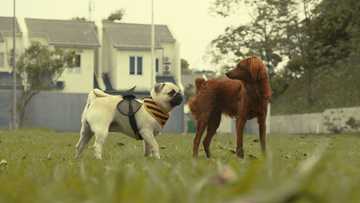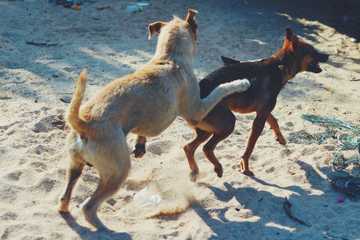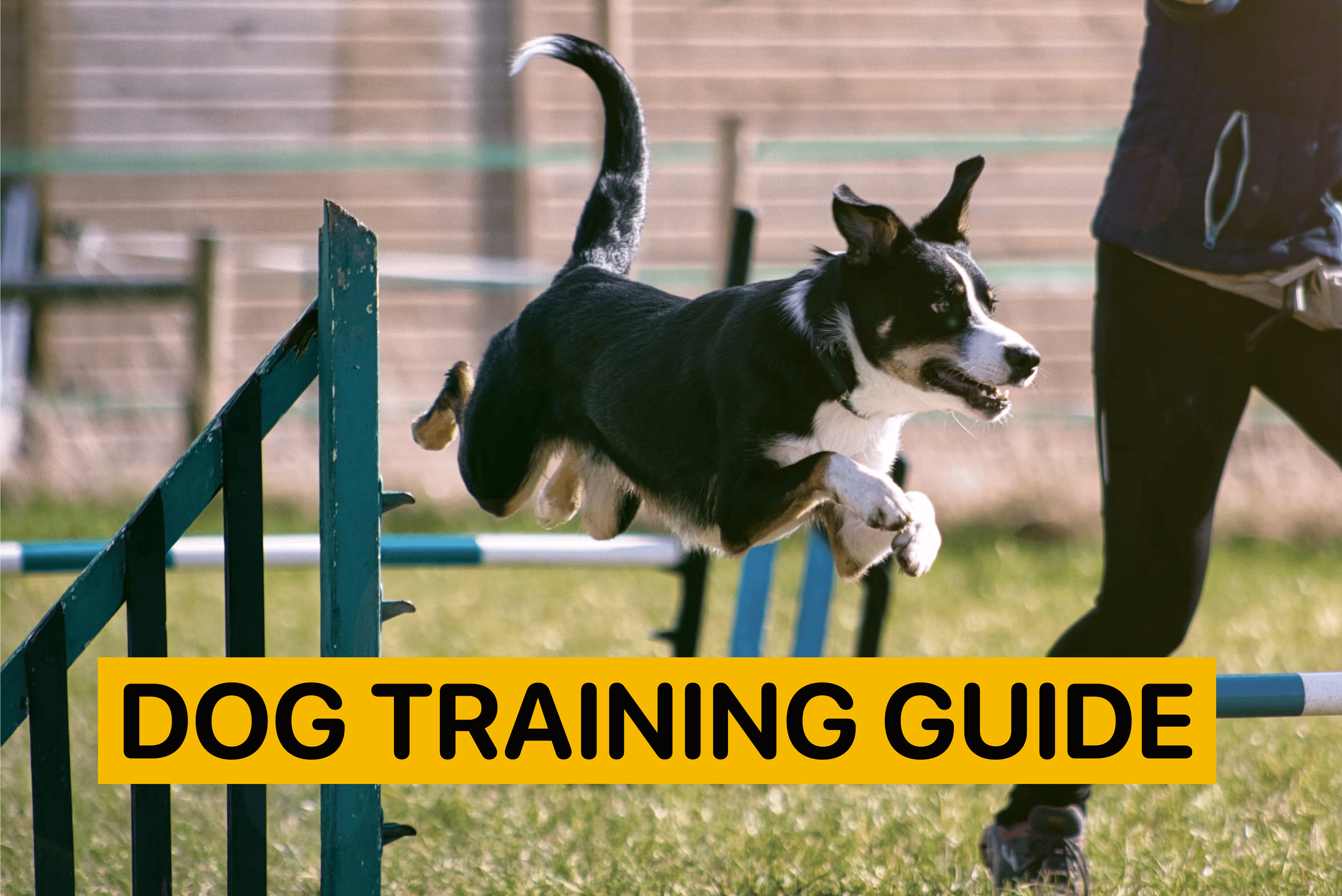Dog Humping Meaning & 8 Working Ways to Stop Dog Humping

By
Woofz Team Updated on |Reviewed by
Karen PiwinskiKey Takeaways
-
Dog mounting behavior is entirely normal and is not always driven by sexual arousal
-
Dogs might hump other dogs, other pets, objects (such as a stuffed animal), people, or even air
-
Humping behavior can often signal that a dog is overwhelmed or bored
-
Puppies start displaying mounting early on and can keep doing it until adulthood (for different reasons)
-
To stop dogs from humping, it’s essential to identify the trigger and work on correcting the habits using redirection and positive reinforcement.
Humping, also known as mounting, is an entirely normal dog behavior. Despite this, many pet parents may be taken aback when they see their dog getting on top of another animal, a person, or an object. Humping is harmless, but since it can be embarrassing and annoying (especially if it becomes a compulsive behavior), you may be interested in finding out how to get a dog to stop humping.
Why Do Dogs Hump? 9 Common Reasons
Mounting is a natural, instinctive behavior canines display in a variety of situations. It can be sexually motivated, but there’s much more to it than an instinct to procreate. From overexcitement to medical problems, mounting can have a myriad of meanings. Let’s dive deeper.
1. Sexual Behavior
The first reason is pretty self-explanatory: humping is a form of sexual behavior. An adult dog will attempt to mount female dogs (we refer to unneutered male dogs and unspayed female dogs) when they’re in heat. The production of testosterone regulates this instinct.

Female dogs, however, are also prone to mounting during their heat. They may start getting on top of people, objects, or any other humping target, most likely due to a rise in certain hormone levels. For both male and female dogs, sexually driven mounting is likely to subside after neutering or spaying.
2. Dominance
Many pet parents believe that humping can be an attempt by a dog to establish a certain status within the pack (family) hierarchy.

Indeed, this behavior can serve the purpose of asserting dominance among canines, but it typically occurs within a specific context (an escalating conflict) and is paired with other social cues. If mounting is directed towards humans, there is another underlying cause for it.
3. Stress and Anxiety
Some dogs turn to displacement behavior to reduce stress and anxiety. Mounting is one of them. This activity allows a canine to redirect their energy and get distracted from anxious feelings.
4. Attention-Seeking
Most dogs crave human interaction, and they’ll do whatever it takes to reach the desired outcome. Suppose your pooch wants to play with you. If they hump your leg, you will immediately push them away in an attempt to stop the mounting behavior.
You may see it as a clear sign that you disapprove of the habit. For your dog, however, it’s a way to get your attention, and you deliver it whenever they hump. In other words, unwillingly, you reinforce the unwanted behavior.

5. Playfulness
Canines often mount as a form of play. Male and female dogs at a young age (around 3–6 weeks) start doing it alike. They may later transfer it to another human or their favorite toy.
6. Learned Behavior
In some cases, dog owners inadvertently reinforce humping. As we’ve already discussed, attention-seeking mounting can quickly become a learned habit. For some male dogs, the habit doesn’t go away thoroughly even after neutering, due to lingering hormone levels in their bodies.
7. Medical Issues
In rare cases, mounting can be rooted in health issues. If your adult neutered dog mounts objects obsessively, you may suspect a urinary tract infection or irritation. For male dogs, it can also be a sign of prostate issues.
8. Overstimulation
If your pet spends a long time in chaotic and sensory-enriched environments, they can get overstimulated.

To calm down and release tension, they try a form of self-soothing behavior. You can often see it when you bring your pooch to a local dog park and they get overexcited about the possibility of play with other animals.
9. Boredom
Boredom is often a trigger for all kinds of unwanted behaviors, including dog humping. A bored dog looks for ways to release excess energy, so ensure your pet gets enough physical and mental stimulation daily.
When Do Dogs Start Humping?
Mounting behavior becomes prominent at different stages of a dog’s life (both male and female dogs), and depending on their age, it can serve a different purpose.
Early Humping (2–4 Months)
Puppies can start humping as early as 2 months of age. At this stage, this habit has no sexual connotations and is not pleasure-seeking. Instead, it’s a way for a pup to interact with their peers, test social boundaries, play, and express their excitement.
Puberty (6–8 Months)
Mounting is a normal behavior during puberty in canines. When they hit puberty, their hormonal levels start to fluctuate. Male dogs experience a surge in testosterone, while female dogs undergo their first heat cycle. All these changes are driving forces behind the increase in attempts to mount.
Despite the newly added sexual aspect, it remains a form of play, energy release, and a coping mechanism for stress and anxiety.
Adulthood
Adult canines, mostly intact dogs, will mount to display sexual interest. Older dogs, who were spayed or neutered, use humping for a variety of reasons, such as stress release, play, social interactions, or medical issues.
How to Stop a Dog from Humping in 8 Steps
1. Identify the trigger
Identify the situations in which your pet resorts to humping.

If there is a tendency to mounting provoked by a specific stimulus, like boredom, anxiety, or overstimulation, work on reducing or avoiding situations that can encourage this behavior.
2. Redirect the behavior
Say “No” firmly and offer the dog an alternative to humping, such as an engaging toy or a game to play. You can also use obedience commands to distract a dog from humping. For example, you can use “Sit” to make your pooch change their body position.
3. Reinforce positive behavior
Use positive reinforcement methods, like treats and rewards, to praise your dog for abstaining from humping.
4. Avoid punishment
Don’t scream, yell, or punish your pet in any way. Remember, mounting behavior can be triggered by anxiety, so punishing a dog will only stress them out and make the situation worse.
5. Time-outs
To avoid reinforcing the habit, you need to teach your dog that it doesn’t result in fun activities.

You can use time-outs for this purpose. For example, when your pet attempts to hump your leg, place them in an enclosed area (a separate room or a crate) to show them the consequences of the behavior.
6. Exercise and enrichment
To tackle boredom, encourage your dog to exercise both outdoors and indoors. Take them to a local dog park regularly, as it provides plenty of opportunities to sniff around and explore the environment. Daily walks, playing games, and other mental exercises help your dog’s brain stay sharp and release excess energy.
7. Spaying or neutering
Spaying and neutering can significantly reduce or eliminate humping behavior in canines.

It’s most effective for sexually motivated humping. However, in some cases, dogs can still resort to the habit as it has become a learned behavior.
8. Consult a professional
If none of the steps mentioned above help your pet to stop humping, consult a certified dog trainer or a veterinary behaviorist who can thoroughly analyze the reason behind humping and help your furry companion break it successfully.
Wrap Up
If your dog starts humping, it can catch you off guard, but this behavior is typical for canines. Identify the reason why your pet has developed the habit and work on correcting it. With a bit of patience and a consistent approach, you can achieve positive results.

